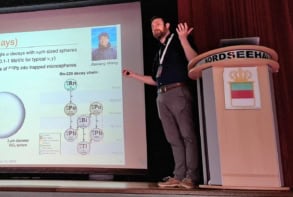
Results from an experiment designed to test the limits of charge–parity (CP) symmetry have been used to restrict the possible mass range of a candidate dark-matter particle. Writing in Physical Review X, researchers with the international Neutron Electric Dipole Moment (nEDM) collaboration report that the absence of oscillations in the electric dipole moment of ultracold neutrons and mercury-199 atoms rules out axion-like dark-matter particles with masses between 10-24 and 10-17 eV.
Axions were first proposed to explain the lack of CP symmetry-breaking in strong-force interactions, although they have not yet been observed. Their existence could also account for some proportion of dark matter, which is the invisible mass component of the universe.
Evidence for CP symmetry-breaking was the goal of the nEDM group’s experiments at the Paul Scherrer Institute in Switzerland. Their apparatus was designed to detect signs of a finite electric dipole moment (EDM) in the spin precession of neutrons and mercury nuclei. The researchers realized, however, that the same data might also reveal the presence of axions.
Suffused with axions
The small mass predicted for axions means that they must permeate the galaxy if they are to contribute significantly to the universe’s dark matter. Interactions between this axion field and gluons and nucleons should produce oscillations in the EDM of the neutrons and atoms in the experiment. No such effect was detected; nor was there any sign of the axion “wind” caused by the solar system’s passage through the galaxy’s dark matter halo.
As a result, the researchers were able to put limits on the axion–gluon coupling strength, and to exclude a wide range of masses for the particle. Longer and more sensitive measurements in the future should make even lighter axion masses accessible to observation.



